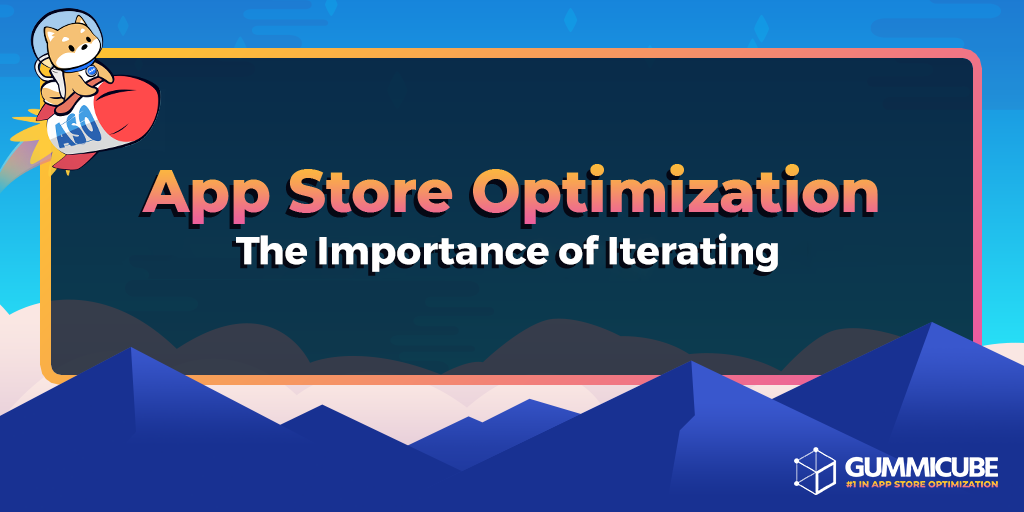App Store Optimization: the importance of iteration
- Friday, April 16th, 2021
- Share this article:
Dave Bell, Co-founder and CEO of Gummicube, considers the ongoing work needed to ensure an app retains a high ranking in the app stores.
 Launching a mobile app is not a one-and-done process. Patches need to be released to fix bugs, UX and performance enhancements are important for keeping users interested, and new features for ever-changing hardware capabilities need to be accounted for.
Launching a mobile app is not a one-and-done process. Patches need to be released to fix bugs, UX and performance enhancements are important for keeping users interested, and new features for ever-changing hardware capabilities need to be accounted for.
App Store Optimization is no different. Updating a store listing and the keywords that go behind getting it to appear in search are not something that can be set on launch day and forgotten about. Changes must be made to become and remain competitive, along with an understanding of when and why to make them.
Metadata updates – technical aspects of indexation
On a technical level, keeping your metadata updated is critical for maintaining and expanding discoverability in search. Each time you update, it forces Apple and Google’s algorithms to crawl the fields where keywords are declared, using them to establish where to index the app in the App Store and Play Store.
With Apple, keywords can be declared directly through the keyword field, and supplemented by the content of the Title and Subtitle fields. Since keywords can be explicitly stated, Apple’s algorithm typically takes a shorter time to index an app after updates: up to 30 days, depending on the volume and velocity of traffic coming in.
Ranking movement after an iOS keyword update will appear volatile shortly after the release goes live. Once indexation occurs, keywords will appear to settle at where the algorithm finds them relevant and fluctuate a bit week over week as users tap on different results in search, other apps launch updates, and new apps are introduced competing for the same terms.
With Google, there is no explicitly declared keyword field. Google’s algorithm must crawl the contents of the Title, Short Description and Full Description fields, looking for keywords to index the app on. Compared to the iOS App Store, Google’s indexation process more akin to how websites are indexed in SEO. The indexation process for Google is a bit longer- up to 45 days, sometimes more – and also depends on the volume and velocity of traffic an app gets.
Keyword ranking movement for Google Play apps typically does not show the same sudden volatility after a change. The algorithm will need time to crawl the app, determine if clicks occur on newly indexed keywords, and either maintain that ranking or remove it from its new position. Google’s indexation process is more of a slow build up towards indexation compared to Apple’s chaotic beginnings that calm down over time.
Metadata updates – update timing and ranking stagnation
Between Apple’s early volatility and Google’s slow build-up, metadata deployments on either platform can take several weeks to index before enough data is available to determine a path forward. If a change is made during the indexation period, a keyword may be kept that will later be shown to underperform; another which may have ended up ranking better could be mistakenly removed. Trying to decide what to change after only a day, or even a week after an update, could be disastrous for the next one.
But what happens after rankings do appear to stabilize? Are these now established spots that can be maintained indefinitely? While they will be stable for a while, over time this stability becomes stagnation leading to a decline. As more apps launch updates, and new apps are released, Apple/Google crawls these other apps to index them in their stores.
If you are not making any changes, and therefore not signaling to the stores to re-crawl your app, competitors simply have more opportunities to compete for keywords you are already indexed on and take advantage of new keywords you haven’t tested yet. Terms that are underperforming will continue to do so, and previously performant terms can start to drop.
From a technical perspective, understanding the length of time indexation takes, and when things start to stagnate, is the key to knowing when to assess performance and release a new update. Updating too early or too late will leave your app at a disadvantage.
Rolling with the changes
The above aspects of launching an update are a starting point, at a technical level, of when to review and plan next steps. While a critical factor in planning a change, these are simply considerations focusing on how an algorithm works. Consider also the whole end goal of the process – getting the app in front of a user, then getting them to download. Changes in user behavior and trends need to be kept in mind.
Depending on the app, seasonality is one factor to capitalize on. Is there a holiday approaching? Does your app provide a utility that becomes more relevant around that time, like making shopping lists, invitations or offering daily deals? Can your game implement a seasonal event, character skin or theme around the season? “Seasonality” for an app may not even be directly related to a holiday, or the weather- it could be from trending popularity around the release of new music, a new series or a sporting event.
Adding these features is a great start, but users won’t know about them unless they are able to find them and see them. As trends change around how users search, research which keywords are trending, incorporate them into your updates and reflect them in the app’s creative. Apple and Google even feature seasonal lists on their curated editorial lists- something as simple as changing your icon for seasonality could lead to increased conversion from end-users who now know your app is up to date, or a second look from the editorial team. Be mindful, though- these same changes in trends that you can capitalize on must be adjusted once the trend dies down.
Changes come and go with each season, but larger, more long-lasting changes in user behavioral trends should also be considered. As new trends emerge, from user search behavior to design in the app stores or the technology of the latest hardware, iterating with regular updates can keep your app up to date in the minds of potential new users.
In summation
The road to irrelevancy is paved once and neglected. Apps require consistent updates from both a technical and a marketing standpoint to maintain a regular flow of app store views and new installs.
Just like not making changes frequently enough, making changes too quickly can be detrimental to success. Once you have an understanding of how the Apple and Google index apps, evaluate what you can do to stay fresh and topical with the changing times.
Research trends in search volume with ASO software; analyze creative asset changes in the competitive landscape; consider how you can ingratiate trending topics both in-app and on-page. Without regularly evaluating and refining an App Store Optimization strategy, even the most successful apps can fall from the spotlight.
About the Author
Dave Bell is Co-founder and CEO of Gummicube. Gummicube is a global leader in App Store Optimization with more than 11 years of experience optimizing and marketing apps. We offer the leading enterprise ASO technology and agency services, providing support to clients around the world. Our company is trusted by thousands of enterprise brands and leading startups including Microsoft, LinkedIn, Bethesda, SWEAT, GrubHub, McAfee and many others.

















